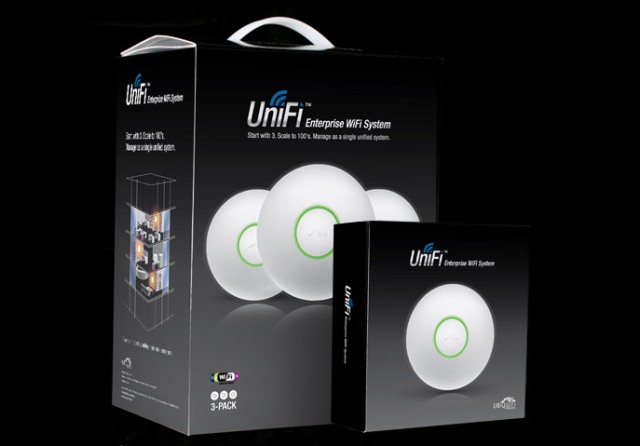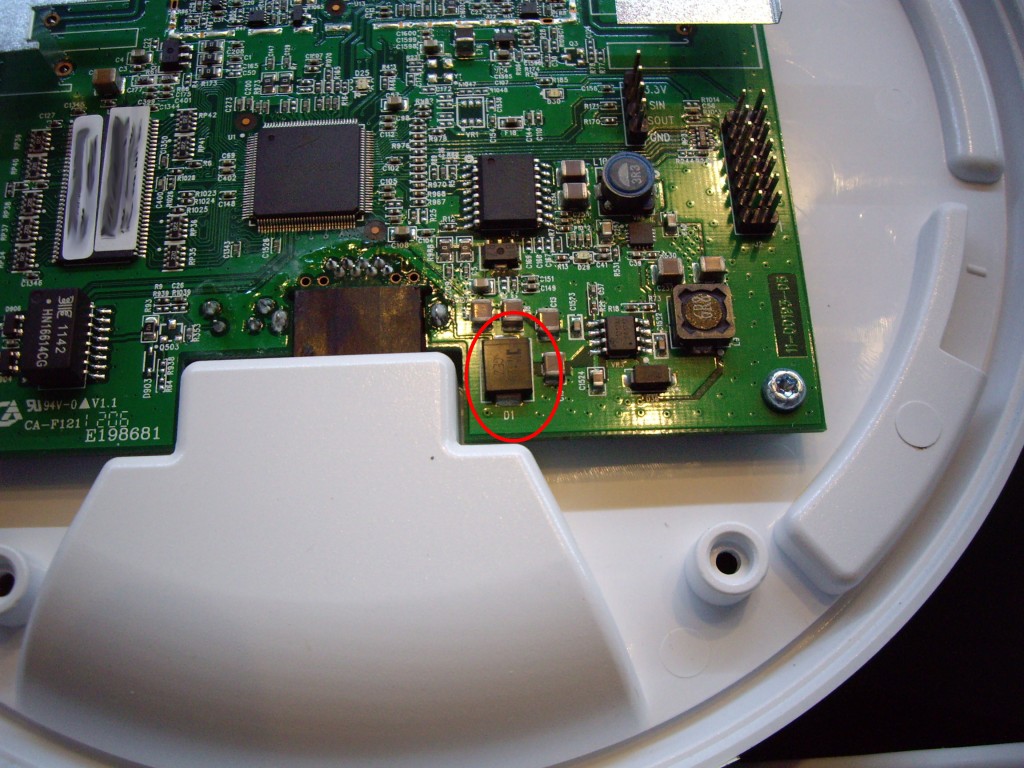We have had a couple of ‘frisbees’ – the excellent Ubiquiti Unifi access points knocking around which were broken. Unusually, they run on 24V POE rather than the more common 48V. One of the minions here in the Labs didn’t realise this and tried to power them straight from a switch with 48V. They broke.

The symptoms were that the power supply light would only flash periodically in sync with an orange light in the device. Unplug the ethernet cable from the frisbee and the PSU light comes on solid. This says power supply is fine, frisbee is broken.
There is precious little information on these devices about fixing them, other than a few people who have done the same as us. The usual answer is ‘its broken – buy another’.
On opening the device (4x torx screws), there is no evidence of damage – no black marks, charring, exploded components to give any clues as to the failure.
One comment I read talked about protection diodes which could be the cause. Looking at the circuit board, the power track from the ethernet connector goes to a voltage regulator chip, and on its way, there are some capacitors to ground and a large surface mount diode labelled ‘D1’. The markings on it are ‘129’ and ‘GEZ’. A little research shows this is a SMCJ24A which is a ‘transient voltage suppressor’ or TVS. GEZ is actually the identification of 24V working voltage rating used by Lite-On Semiconductor. This component is there to ‘clamp’ the voltage if it goes above 24V (actually somewhere between 26.7 and 29.5V) in order to protect the more sensitive circuits from voltage spikes (or people plugging in the wrong POE). In our case it had done its job in protecting the rest of the board, but has partially failed in that it won’t pass 24V for any length of time.
It is not too difficult to remove D1 using a soldering iron and some long nosed pliers. Plugging in the board with D1 removed shows it works, but D1 is there to protect from spikes and so it is a good idea to replace it. The component costs pence each and is available from RS Components here. When soldering it back in, make sure you get it the correct way round; there is a line on the top at one side – this goes away from the edge of the board – towards the top on the picture above.
Update:
We have two broken APs – with D1 removed, both of them light the LED D29 which indicates power, and both have 3.3V on the JTAG port. One of them shows network activity when the ethernet port is plugged into the network – LED D30 flashes, but the other does nothing else. Sometimes LED D25 (the yellow/green one) lights up orange when it is powered up, sometimes not. I think this one is definitely for the bin. The other one has a working boot loader. If you power it on whilst holding the reset button down, D25 goes green after about 5 seconds, and then cycles orange/green/off after 10+. I think it does need the BIOS reinstalling though..
For anyone following this, I suggest removing D1 (even by cutting it in two with side cutters) and then powering up. You can then assess the condition of the rest of the board before sourcing the replacement TVS. These things aren’t that expensive, so no point in wasting loads of time on it..

I had the same problem but only found this post after diagnosing the problem as I searched for Unif and GEZ. Additonal search terms that my assist others AC-adapter flashing, power flashing.
that part is not the right part at all…
its like half the size of the original part…
are you sure you listed the correct part in your blog?
Hi Tony,
The data sheet lists the dimensions as 4.57 x 3.94 x 2.24mm. What size is yours? I bought/fitted one of these (listed on RS as TVS Diode Uni-Directional SMBJ24A-E3/52 38.9V, 600W, DO-214AA 2-Pin) and it was exactly the same size. Maybe the part has changed?
hmmm I used the same model number listed on another site… since I’m not in the UK. thanks for the dimensions I will search for another site with the same dimensions/model number.
The part I got was also half the size, but the specs were exactly the same as one listed on RS. I bent the contacts out slightly so I could solder it on. AP is working fine.
That’s great to hear!
This post is a gift that keeps on giving. I fried not one but two unifi units yesterday. Needless to say that was quite embarrassing and I needed them running tomorrow. Your instructions were quite clear and my unit boards looked exactly like the picture you posted.
I have no electronic skills, but your ” even by cutting it in two with side cutters” gave me courage. I simply used a pair of needle nose pliers to pull, twist, and ultimately break off the D1 protection diode. Both units worked fine after that. I don’t have the skills to find and solder a replacement diode, so hopefully I have learned my lesson.
Thanks much for taking the time to write this up. I’d love to buy you a beer so send me a note if you have PayPal or some other way I can do that.
Hi Bill,
Glad to hear it worked for you.
If you feel in a giving mood, here is what I am supporting at the moment: https://rbs.sponsorme.co.uk/andrewhazley/theos-hope-4-sound.aspx
Excellent…done.
This is a great post, but I am wondering if you have any comparable information on the new line UAP-AC-LR units. I have fried mine with 48 volts, but I cannot find any diode that looks suspicious like the one you pointed out for the UAP-LR.
Sorry – I have not fried one of them!
You can take your pick of 3 dead specimens I have at laying around! These died as a result of a Unifi switch power cycle error were apparently during the power up cycle it sends 48v poe to all ports, regardless if they are set to 24v. I couldn’t figure out why I always lost APs when the switch was rebooted. After the 3rd one died, I started to research. Apparently there was a bad batch and they had a recall.
Here you go. I “repaired” my UAP-AC-LR tonight.
David, were you able to identify the specific diode on the UAP-AC-LR? I can’t seem to find any article identifying the specific diode when fried. Thanks!
Diode D23 near the Big 6R8 resistor-
https://www.youtube.com/watch?v=cbVWpp_m75g
I had a tech fry two of unifi AP’s with a homemade 12v POE injector. These AP’s weren’t terrible expensive, but I hate to see anything go to waste. So I went to amazon.com and bought 50
http://www.amazon.com/VISHAY-SEMICONDUCTOR-SMBJ24A-E3-DO-214AA-pieces/dp/B011NAF26W/ref=sr_1_1?ie=UTF8&qid=1458270639&sr=8-1&keywords=VISHAY+SEMICONDUCTOR+SMBJ24A-E3%2F52+TVS+DIODE%2C+600W%2C+24V%2C+DO-214AA
I used toe nail clippers and cut out the old semi conductor on D1, then used wire glue to “solder” it back to the board. Plugged it in and immediately it was discover-able again.
http://smile.amazon.com/Sciplus-Electrically-Conductive-Soldering-Wire/dp/B000Z9H7ZW/ref=pd_sim_469_4?ie=UTF8&dpID=515qUqdqffL&dpSrc=sims&preST=_AC_UL160_SR83%2C160_&refRID=174KJ7E2PSGNFJK0N7HN
THANK YOU SOOO MUCH!!!!
you have def saved me a lot of money now and in the future!
Cool! Worked for me, just by removing the diode. Looking to order a replacement diode in The Netherlands. I wonder, how did you find out the specs of the thing?
Thanks a lot…
For us this solution work on 3 items Ubiquiti UniFi AP.
With removing on D1 they powered on and work fine, after that test we mounted TVS diode SMBJ24A and they works again.
Great to hear!
What is the fix on an AIRFIBER 24 unit, that will power with 48VDC but will no longer make a link at 1 gbps only 100mbps. ???
Thanks – I’ve got five units I need to repair. It’s costly to ship these things, and I can’t find anyone in MT who is doing electronics repair at this level.
This is a TVS diode, Uni-direction and the band mark is cathod , goes to + side of 24vdc rail.
sold at mouser.com
it is clamp diode, over-volage clamp’er,. and shorts when bad. (it’s only job is this)
https://www.mouser.com/ProductDetail/Vishay-General-Semiconductor/SMBJ24A-E3-52?qs=%252BKsK5HlK7GHZXpd2SJWmDQ%3D%3D
SMBJ24A-E3/52
the original TVS was from “ONN” semi
this new one is Vishay.
or call it a surge suppressor, it is that too. 48vdc kills it ,by DESIGN./